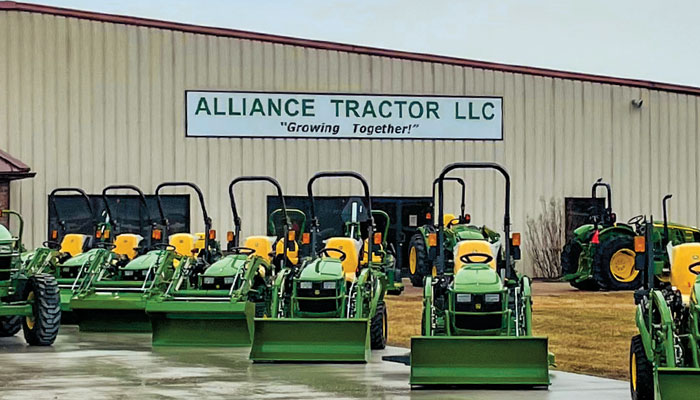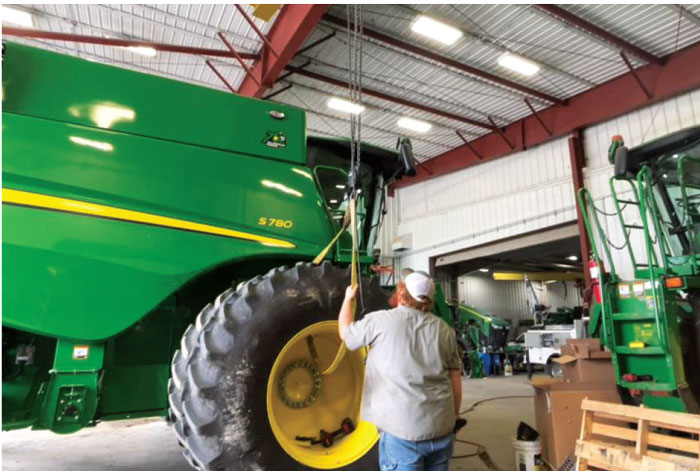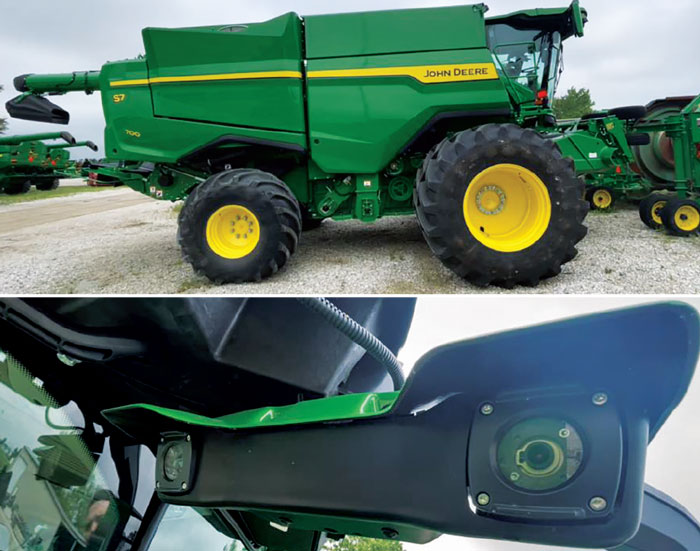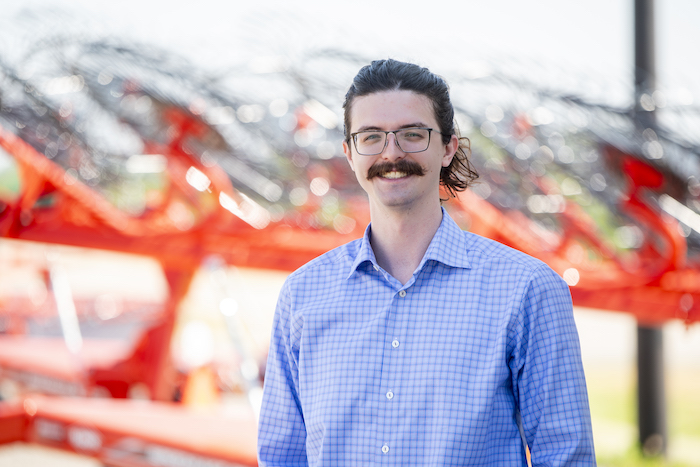It’s raining again at Alliance Tractor’s Vincennes, Ind., store in mid-May. The 4-store Indiana and Illinois John Deere dealership has faced unprecedented rainfall the past few weeks, dragging out its customers’ planting season and creating a wide spectrum — from some just getting started to others approaching the mid-way point — among local farmers.
One of the questions posed in Part 1 of Farm Equipment’s “Boots on the Ground” series was whether or not farmers near the Vincennes store, nestled between the Wabash and White Rivers in southern Indiana, would see a healthy start to 2024. Unfortunately, the worries of excessive rain were confirmed. But operating in a region known for jokes about “building the Ark,” this isn’t Alliance’s first rodeo.
There’s big news to discuss, too. The 22-store Illinois and Wisconsin John Deere dealer Sloan Implement announced in late March that it was acquiring all 4 of Alliance Tractor’s stores effective July 15. While lots of specifics are yet to come, optimism is in the air at the dealership. Being part of a larger dealership means more inventory to access, more seasoned veterans to call upon and the widespread resources that large groups can afford. In the months ahead, the Vincennes staff will learn how to be part of Sloan Implement, but just as important, need to communicate to their customers that the personal touch for which it’s known will remain.

Well before customers see the Alliance Tractor sign officially coming down, the Vincennes team is reaching out to all customers, making sure no one is surprised at the merger and rebranding when the time comes in July. All photos by: Ben Thorpe
On top of all that, the team still hasn’t been able to get its new See & Spray-equipped sprayer (a hot topic on Farm Equipment’s last meeting) out in front of any farmers yet due to the spring chaos keeping everyone tied up. Plus, there’s now a limited production Deere combine in back (complete with new front-facing cameras) that staff needs to understand and get out in the field for demoing.
2024 is already shaping up to be the most unique year in Alliance Tractor’s 9-year history. And this is only Part 2 in the 4-part “Boots on the Ground” series.
Handling the Wettest Spring in 5 Years
Store Manager Jason Boyles says this year’s planting season has brought the most rain to the region since 2019. One this day in May, one exhausted customer expressed he had 3,500 acres left to plant. Another call reported 4.5 inches of rain the night before that will force a total replanting.
Local no-till farmers (there’s a large population around Vincennes) will see greater challenges, says Boyles, without the practice of opening the soil to dry it out. But this unusually intense rainfall doesn’t spare growers of conventional practices either, as runaway topsoil fills the ditches.
“In late March, a couple guys really got going for a couple weeks,” says Seth Kocher, Integrated Solutions sales/support. “Since then, you get 1-2 good days, so guys start going. And then you get a good rain and they might be out for 3-4 days,” he says. “In some of the sandy soil they’re able to get back into it, but some in the more clay-based soils don’t infiltrate water as well, so those guys haven’t been able to get back in at all.”
There’s a silver lining to the wet spring, however, from a precision standpoint. The “start and stop” planting has given the Integrated Solutions team additional time to get out into the field and diagnose problems that may have otherwise been ignored by growers until planting was done.
“We’ve been holding about a 3.9% fixed rate on our used equipment…”
“It could be their planting data, and they’re starting to look at that because some of that’s already come back,” Kocher says. “They’re thinking a little farther ahead, or they’re able to make in-season changes. Even in the middle of the season here, it rained, and they have the chance to change some stuff. We’ve had more mid-season changes than I’ve seen in the past.”
These conversations also show the Integrated Solutions team which technologies are best suited for different customers. This is feedback that otherwise might not come until the planters are arriving in the shop for winter service.
One impact that is top of mind for Kocher is how a stretched-out planting could lead to a stretched-out harvest with the widely variable stands out there.
Store hours are fluctuating with the weather as well. Employees are interrupting Boyles to clarify when the store will keep extended hours to service farmers who are making the most of drier planting days. Mother’s Day plantings caused some issues — while a parts counter employee was working, none of the techs had been scheduled.
“It makes your shop techs a little bit more idle than if people were in the field,” he says. “Then you get a window of 2 or 3 days where farmers can actually run — and then they run for almost 24 hours a day. When this happens, you’re getting calls at an abnormal time.
“We had a farmer run until 4:30 a.m. until his tractor broke down. He was stopped until our techs arrived at 7 a.m. If he hadn’t broken down, he was ready to run all morning and through the next day.”
New Opportunities & Resources Through Acquisition
Alliance Tractor has slowly started to learn Sloan Implement’s systems and processes for the deal that will close in July. Yet the benefits of having a 26-store network are already rolling in.
“We’re in communication with the Sloan Implement store in Assumption, Ill., on some deals we’re working on right now,” Boyles says. “If we’re pricing a new sprayer or planter that’s on an early-order program, we know that by the time it comes in we’ll be a Sloan Implement store. That involvement is going to be a good thing. We’re going to have 26 total stores, and that means 26 different parts departments we can pull parts from. We’ll have a massive parts inventory.
“Last year, I had a couple guys looking at sprayers for year-end purchases, both looking at the same sprayer. I didn’t get to sell one of the farmers because we only had one out of our 4 locations. We won’t have that problem with 26 stores to pick inventory from.”
The fact that Sloan has been family-owned for almost 100 years means something to Boyles. Owner Tom Sloan and his son, President Jeff Sloan, work every day out of the Assumption store. Both have met with Boyles and the Vincennes team. The culture emphasizes the minimization of middle management, something Boyles appreciates.

Getting select pieces of used equipment in front of techs for conditioning and prepping helped the Vincennes store move more used planters and sprayers than had been expected this spring.
“They don’t have a vice president of sales, and they don’t have used equipment managers,” he says. “It’s essentially Tom and Jeff and the CEO Jim Steck out of Assumption. Each store has a location manager, a parts manager and a service manager, and in some cases 2 service managers. That’s it.
“They don’t want a lot of middle management. They want store managers to run the stores how they feel like they should be run. As long as everything is running smoothly, we’ve been told there won’t be a lot of changes. So we’re excited about that part of it. From what I’ve heard so far, both operations are very similar. It should be a fairly smooth transition.”
Salesperson Ryan Seger values Sloan Implement’s focus on growth throughout the transition. Where soon to be acquired dealerships often worry about layoffs with an acquisition, Seger says Sloan Implement is asking what Alliance Tractor needs added to the operation to pursue growth. In fact, one of the only employees not staying for the transition is a retiring tech.
“But discussions have been the opposite of headcount worries,” Seger says. “When they came down they asked, ‘What do you guys see your future needs being?’ We talked about the importance of adding the AMS technicians and more service techs. They were all for that — it was good to hear.”
One ongoing discussion revolves around how shared customers will be handled, with a goal of avoiding 3 salespeople fighting over the same customer and the confusion that will cause. Ultimately, he says, it was decided that it’d be the customer’s call on where they’re most comfortable.
Another benefit will be access to Sloan Implement’s customer-facing aftermarket parts business: Sloan Express. This portion of the business is also based in Assumption, and Boyles plans to take the service team over there once planting is over to check it out.
Sloan Express currently offers just over 9,000 parts from 73 different brands. “It’s just another avenue of parts we’ll be able to have to offer our customers that we never had before,” Boyles says.
Boyles admits most employees and even customers have some anxiety about a change of this scale coming to Alliance Tractor, and more questions will come up as the year continues. But he says overall customer sentiment has been positive. Farmers closer to competing John Deere dealer Hutson are happy they can still get quotes from 2 different Deere dealers if they need to, Boyles adds.
There are, however, misconceptions. What no one wants, he says, is for a customer to find out about the acquisition as they’re driving up to the store and see the new sign.
“I’ve heard, ‘You guys are being acquired, you’re not going to give us anything on our trade-ins’ and things like that,” he says. “I’ve heard people say they’re concerned Sloan won’t allow us to do this or that. That’s why we’re spending a lot of time on the phone and in the pickup truck, seeing customers, and trying to alleviate some of those concerns.
“I tell them I don’t have a crystal ball. I can’t see several months in the future. But from the conversations we’ve had with Jim Steck and Tom Sloan, it’s all very positive.”
Some farmers have shared the bad experiences they saw when their local dealer was acquired. Customers heard stories of newly-acquired stores losing technicians, parts inventory and responsiveness. But the Alliance staff continues to stress that those customers’ key contacts at the store will remain and that they’ll keep frequent contact to make sure there aren’t any issues.
Checking in with Parts Manager Jamie McNeely
During this visit, both Service Manager Roger Roberson and Parts Manager Jamie McNeely were on the move constantly. In a later phone interview, McNeely says between sporadic rain keeping planting windows and upcoming wheat harvest tight, the whole parts department was all hands on deck and firing on all cylinders.
“We get the bulk of our business when it rains,” he says. “They have a tendency to get through when it’s not it starts raining, they want to come in and make repairs and get things ready to go for the next round of going back to the field.” With Alliance’s customers all facing different planting conditions, McNeely hasn’t identified any particular wear parts needing more replacement this spring than in previous years. However, he hopes to call some of his dealer contacts around the country once things have settled down to talk about the wheat harvest. By then, some will have finished and he can pick their brains about how it went before the Vincennes store dives into its own wheat harvest.
McNeely doesn’t see this uniquely wet spring impacting his department down the road too much. However, the extended planting season will start to cut his techs into 2 camps, he says: half working on getting the remaining planters serviced and in the field, and the other half switching to preparing combines to harvest wheat.
“As soon as the acquisition was announced, the phone started ringing,” Seger says. “There were these wild things being said, like they were going to close stores and that Vincennes store would close. Anytime there’s uncertainty, there’s anxiety. All of us did our best communicating with customers as quickly as we could.”
Blessed with a Precision Call Center
During his interview, a colleague stepped into Kocher’s office to ask how many Sloan Implement shirts he wants to order. It’s an example of the scope of the change coming and how it’ll impact every part of the business, from letterhead to staff uniforms.
Sloan Implement’s precision call center — which is staffed by Integrated Solutions employees on a rotation — will be among the biggest benefits Alliance sees out of the acquisition, according to Kocher.
“It’ll help us focus more on in-field problems,” he says. “The call center guys have the capacity to answer questions that may take just 10 seconds. If we’re in the middle of something, we can’t answer the phone all the time, so this will be big for us all.
“They rotate us out to all the stores to man the call center, so there’s not one person just sitting in an office for a week. You get rotated out. From my understanding, they’re in the call center for 1 day per month. It’ll be interesting to see how it affects our customers and if they utilize their availability, but it definitely will be beneficial.”
Seger has been careful with how he talks to his customers about the call center, so as not to give the impression that Alliance is replacing their “boots on the ground” mentality. There’s no substitute for that, he says. Part of this is staying in close communication with farmers over the next 6-12 months and getting their feedback on the transition.
“I want to be very careful because I don’t want customers to think all our resources will only be in phone support — that’s not the case,” says Seger. “I tell farmers if you have questions about setting AB lines or if there’s some simple issues, we can remote display them to technicians.”
That large pool of precision experts operating the call center also represents decades of experience Kocher can utilize, particularly for precision challenges he’s never seen before.
The acquisition also gives Kocher a larger inventory of used displays and receivers — he currently has none — to keep customers from heading to competing Deere dealers for their precision needs.
“Ever since I’ve been here, we’ve had a lot of products,” Kocher says. “At one point we had 20-30 receivers on our shelf that were used. But we had times where we got low on inventory. We’d have to check with a competing dealer or buy something off Facebook to avoid a customer who’s 30 miles away from going somewhere else.”
Used Equipment ‘Plan of Attack’ Pays Off
In late February, Seger and Boyles referenced a spring “plan of attack,” their coordinated effort for moving used equipment. Used planters and sprayers ranked as high priorities. Looking back now, the team found some unexpected success in those segments. He attributes it to cleaning, painting and investing in conditioning in select machines to create the best first impression possible with customers.
“We did a decent job this year, but it’s been hard to even get out in the cabs with guys because of planting,” he says. “Even getting guys started up with new and used planters that we’ve sold them is always a big challenge. Seth and Gerald, our Integrated Solutions guys, are the ones who make all the technology work. They’re my go-to guys at getting people started in the field after we sell a planter.”
In the face of unwavering interest rates, Boyles says the team is also buying rates down to help get used planters and other equipment out the door.
“We’ve been using funds that we set aside when we sell new equipment to buy interest rates down on our used stuff,” he says. “We’ve been holding about a 3.9% fixed on our used equipment. We’d been doing that with planters, tillage tools and some vertical tillage tools. The new stuff is about 6.5% and that’s been steady here for the last few months. It’s not a great, but it could be worse.

John Deere’s limited production S7 combine features 2 large cameras on both sides of the cab to analyze the crop about to be harvested and maximize harvesting efficiency.
“We have even done a few 2.9% on some planters and sprayers to help get some of that moved. And that was another factor in moving a few of those planters and sprayers — throwing out a 2.9% fixed for 5 years, which is largely an unheard-of rate right now in the market.”
Another benefit from the upcoming Sloan acquisition, says Seger, is having more specialists for answering customer questions, particularly when moving sprayers.
“They have guys who are very skilled with sprayers,” he says. “I had a customer ask a question about AutoPath and operating the sprayer on hills. We’ve got a specialist up in Wisconsin and Minnesota where they have rolling ground, and he shared some tricks their customers were doing with sprayers to hold on the slopes.”
New Combine Tech for Wheat Harvest
During this visit, Alliance Tractor had a limited production S7 combine on the lot that it’d been demoing for wheat growers.
“We have a few customers in mind who’ve already expressed interest in it,” Kocher says. “It won’t necessarily be a rental, but more a ‘demo for a couple of days’ depending on the weather. They can use it, and we get their feedback, ride with them and see what they like and don’t. We’re trying to see if that’s something our sales team can market because it’s being aimed at small group of customers. And on the precision subscriptions part of it, we’ve had some negative feedback. When we demo the machine and see it in action, it’ll be interesting to hear feedback and how it might benefit them.”
The combine involves a mentality shift from reactive to proactive, says Boyles, as the cameras on the combine move to the front to assess what’s about to be harvested. Instead of analyzing what’s behind the combine to learn what just happened, the machine studies what’s in front of it and make changes to maximize the harvested grain quality of what’s ahead.
“When it was a reactive system with rear-facing camera and you’re on a sand null, you’re in 30-40 bushel an acre ground,” he says. “Then you get down into your better ground and you instantly go to 70-80 bushels. With all the material, there was a chance to slug the combine. With this new system with the cameras, it’s going to be a look-ahead feature with soybeans and wheat that examines the crop material, the density of it, and whether to speed up or slow down.
Subscription-Based Precision Tech
The store is also planning to demo the John Deere See & Spray unit it got in a few months ago, thought the delayed planting chaos had put it on ice.
One See & Spray feature farmers haven’t been crazy about is how they pay for it. In 2024, See & Spray functions on a credit system where farmers pay in advance for a certain number of hours to use the machine. When it runs out, the unit goes back to traditional broadcast spraying rates. Growers can call Alliance Tractor to replenish those credits, and it all evens out to about $4 an acre on corn and $5 an acre on soybeans.
“On the See & Spray especially, that’s been the most negative feedback I’ve heard on, and they haven’t even run it yet — they just don’t like the idea,” Kocher says. “You want guys to try it first and get the quirks out and then farmers get a better idea of what they’re getting.
“It’s an interesting piece of machinery, and it can be very beneficial if someone uses it the right way. If your whole field is covered in weeds and you go out there and try See & Spray, it’s going to spray your whole field and you’ll say it didn’t save anything. Well, it’s not going to in that condition. We’ve got to be thinking when we demo it, and the right guys and make sure they use it on the right fields where they’ll enjoy that full benefit.”
Learn More Online
- For more on this series, click here.
- For more on this visit to Alliance Tractor, click here.
Seger believes an ROI calculator will be key to selling farmers on See & Spray, something they may be able to draw upon after the Sloan acquisition. He also believes food-grade corn farmers may begin to see requirements in their contracts around use of technologies like See & Spray in the future.
“What’s the payback on this technology?” he asks. Because some customers expressed concern as far as chemical prices dropping. He’s been asked question of ‘How many more acres do I have to run now to offset that?’ If chemical prices were where they were last year, it’d an easier justification. But with the chemical prices coming down, some customers express concern on the $4 an acre costs.”
By 2025, Boyles says farmers will be done with the credit system and will simply be invoiced for the tech as they use it. This will remove the need to forecast how many credits a farmer needs for the season and keeps customers from getting stranded on a Sunday when their credits run out.
“This year, we must ask how many acres they think they’ll use See & Spray on,” Boyles says. “‘It’s going to be X amount of acres.’ ‘OK, I’m going to sell you X amount of credits. If you use all of them, we can sell you more. If you don’t use all of them, we will refund you the credits after the season’s over.’
“For 2025, it’ll be sold as you use it. If someone bought a sprayer with See & Spray, he would run it for a month and then get invoiced for whatever he used for that month.”
Part of the rationale for the subscription model, says Boyles, is Deere believes the total upfront cost of the See & Spray technology would be too high to sell it.
Harvest Expectations
Kocher isn’t expecting an increase in precision tech sales over the next few months as summer is usually his department’s downtime, when farmers aren’t making many changes to their equipment. He’ll be focusing on educating customers on the new call center, how they can use it and what benefits it will bring them.
Boyles is currently concerned about the ongoing lull in commodity prices, as well as how current planting conditions could impact yields in the fall.
“Wet weather is not just in our area,” he says. “It’s affecting a lot of the Corn Belt. I don’t know if that’ll be a factor by fall. It seems the earlier planting toward the end of March is the better yielding crop all the time for soybeans and corn.”
Seger shares the same concern, saying some farmers may lose 20-30 bushels per acre on their corn, which would throw a wrench in all equipment purchases. And while he says it’s too early to panic, Seger was concerned some farmers may have to take USDA Prevent Planting, which would complicate sales even further.
Looking at sales for the next 3 months, Seger says there’s a focus right now on tillage tools. They recently lowered prices and have put efforts into generating leads online. And with wheat harvest coming, Seger says they’ll be shifting focus to platforms, headers and combines very soon.








